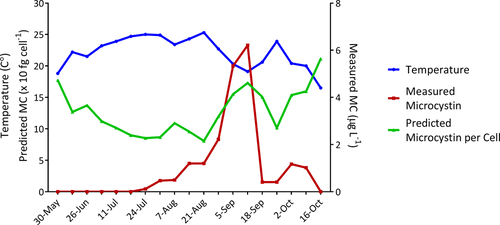当前位置:
X-MOL 学术
›
Environ. Sci. Technol.
›
论文详情
Our official English website, www.x-mol.net, welcomes your feedback! (Note: you will need to create a separate account there.)
Seasonally Relevant Cool Temperatures Interact with N Chemistry to Increase Microcystins Produced in Lab Cultures of Microcystis aeruginosa NIES-843
Environmental Science & Technology ( IF 11.4 ) Pub Date : 2018-03-19 00:00:00 , DOI: 10.1021/acs.est.7b06532 Guotao Peng 1 , Robbie M. Martin , Stephen P. Dearth , Xiaocun Sun , Gregory L. Boyer 2 , Shawn R. Campagna , Sijie Lin 1 , Steven W. Wilhelm
Environmental Science & Technology ( IF 11.4 ) Pub Date : 2018-03-19 00:00:00 , DOI: 10.1021/acs.est.7b06532 Guotao Peng 1 , Robbie M. Martin , Stephen P. Dearth , Xiaocun Sun , Gregory L. Boyer 2 , Shawn R. Campagna , Sijie Lin 1 , Steven W. Wilhelm
Affiliation

|
Freshwater cyanobacterial blooms are regularly formed by Microcystis spp., which are well-known producers of the hepatotoxin microcystin. The environmental factors that regulate microcystin synthesis remain unclear. We used reverse transcription-quantitative PCR (RT-qPCR), metabolomics, and toxin profiling (both by LC-MS) to measure the response of Microcystis aeruginosa NIES-843 to nitrogen (N) concentration, N chemistry (nitrate versus urea), and a range of seasonally relevant temperatures. Growth rates at lower temperatures were slower but resulted in increased cellular microcystin content (quota), and at these lower temperatures, N concentration had no effect on toxin production. In contrast, at warmer temperatures, reduction in N concentration increased toxin production, especially when urea was supplied as the nitrogen source. Our culture results demonstrate how temperature may lead to physiological responses ranging from slow growing yet very toxic cells at cool temperatures, to faster growing but less-toxic cells at warmer temperatures. This response represents a key interaction in bloom dynamics. Capturing this phenomenon as a temperature-driven toxin phenotype incorporated into models might improve the ability to predict microcystin biosynthesis during cyanobacterial blooms.
中文翻译:

季节性相关的低温与N化学相互作用,增加铜绿微囊藻实验室培养物中产生的微囊藻毒素NIES-843
淡水蓝藻水华由微囊藻属(Microcystis spp。)定期形成,微囊藻属是肝毒素微囊藻毒素的著名生产商。调节微囊藻毒素合成的环境因素仍不清楚。我们使用逆转录定量PCR(RT-qPCR),代谢组学和毒素概况分析(均通过LC-MS)来测量铜绿微囊藻的反应NIES-843中的氮(N)浓度,氮化学性质(硝酸盐对尿素)以及一系列与季节相关的温度。较低温度下的生长速度较慢,但导致细胞中微囊藻毒素含量(配额)增加,在这些较低温度下,N浓度对毒素产生没有影响。相反,在较高的温度下,氮浓度的降低会增加毒素的产生,特别是当尿素被用作氮源时。我们的培养结果表明,温度如何导致生理反应,从低温下生长缓慢但毒性很大的细胞到高温下生长较快但毒性较小的细胞。该响应表示绽放动力学中的关键相互作用。
更新日期:2018-03-20
中文翻译:

季节性相关的低温与N化学相互作用,增加铜绿微囊藻实验室培养物中产生的微囊藻毒素NIES-843
淡水蓝藻水华由微囊藻属(Microcystis spp。)定期形成,微囊藻属是肝毒素微囊藻毒素的著名生产商。调节微囊藻毒素合成的环境因素仍不清楚。我们使用逆转录定量PCR(RT-qPCR),代谢组学和毒素概况分析(均通过LC-MS)来测量铜绿微囊藻的反应NIES-843中的氮(N)浓度,氮化学性质(硝酸盐对尿素)以及一系列与季节相关的温度。较低温度下的生长速度较慢,但导致细胞中微囊藻毒素含量(配额)增加,在这些较低温度下,N浓度对毒素产生没有影响。相反,在较高的温度下,氮浓度的降低会增加毒素的产生,特别是当尿素被用作氮源时。我们的培养结果表明,温度如何导致生理反应,从低温下生长缓慢但毒性很大的细胞到高温下生长较快但毒性较小的细胞。该响应表示绽放动力学中的关键相互作用。



























 京公网安备 11010802027423号
京公网安备 11010802027423号